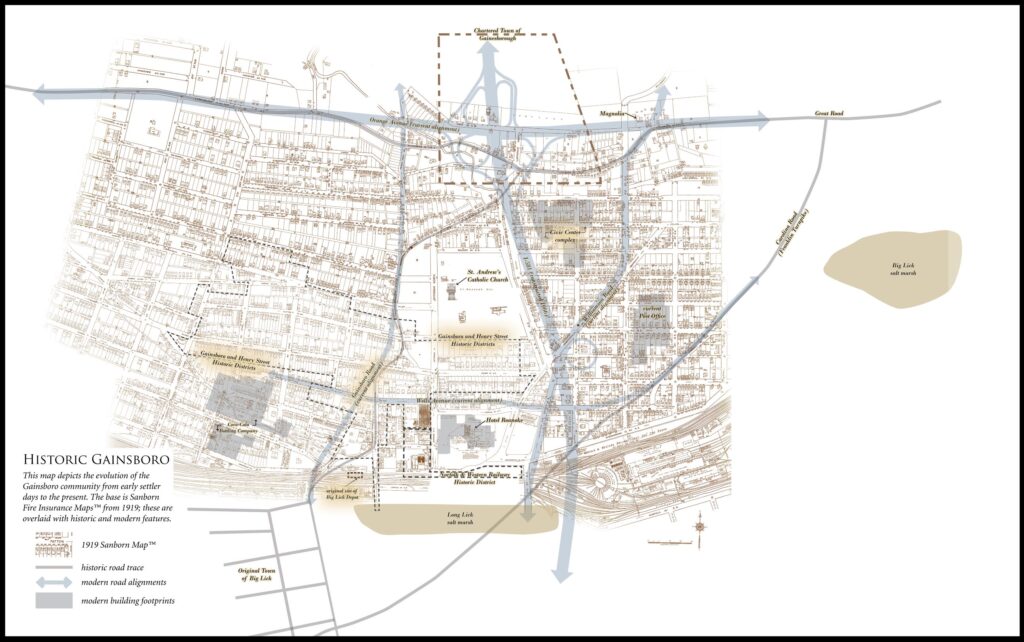“Urban renewal in Roanoke hung on the thesis that the African American ghettos were grossly inferior to the beautiful [new suburban] neighborhoods. Midcentury civic improvement, those in power argued, depended on clearing out the slums and replacing them with new structures that would deepen the city’s claim to civic beauty. What those in favor of urban renewal could quickly begin to claim was that tax revenues had multiplied as a result of putting the land to new uses. ” —Mindy Thompson Fullilove, Root Shock (2016), p. 94.
Urban Renewal in the United States
Urban renewal was a program enacted and funded by the federal government and implemented by local municipalities from 1949 to 1974, to help address disinvestment and deterioration in cities at a time when suburban growth was diminishing urban resources. It was established by the National Housing Act of 1949 and amended by the National Housing Act of 1954. In many communities, including Roanoke, other federal initiatives, such as public housing and interstate highways, followed in its wake.
The goal of urban renewal programs was to improve housing stock and revitalize cities. The federal government provided grants and loans to municipalities for clearance of slums and blighted properties to repurpose these sites for new public and private redevelopment. Over the course of the Urban Renewal program (1949-1974), the federal government approved $13.1 billion in grants for 3,284 projects in 1,258 localities.
By the late 1960s urban renewal had become controversial because it destroyed affordable housing, displaced families, and had a major impact on minority neighborhoods. In addition, it failed to achieve new development in a timely manner. Those displaced from renewal areas often saw little economic benefit, and the social and cultural ties within minority neighborhoods were destroyed in the name of slum clearance and redevelopment.
The national program was called urban renewal; black Roanokers came to call it “Negro removal.” —Mary Bishop, Racial Remapping (n.d.), p. 3.
Eminent Domain
Government agencies used eminent domain—taking private property for public use, with compensation—as an initial step towards clearance and redevelopment. Residents and business owners of designated slum or blighted areas targeted for urban renewal were forced to move, often with very modest compensation. Therefore, many found it difficult to find a new location for their business or affordable replacement housing.
Urban Renewal in Roanoke
Urban renewal was embraced by Roanoke city government leaders as a way to improve deteriorating physical conditions and encourage new business investment in downtown and in older neighborhoods north of downtown. The City applied for and received federal funds for four urban renewal projects from 1955-1974. These funds were administered by the City and the Roanoke Redevelopment and Housing Authority, a council-appointed board with defined responsibilities for housing and redevelopment under state and local law. Urban renewal efforts were done in accordance with adopted federal, state, and local program requirements.
What is recognized now is that the ultimate impact of urban renewal was tragic for the established African American communities of Northeast Roanoke and Gainsboro. The segregated history of the city contributed greatly to property values, the perceptions of neighborhood conditions, and to the decisions made by government leaders, who were mostly white. Not enough attention was given to the social and economic effects that resulted for the minority persons displaced from these targeted neighborhoods. The scale, legacy, and effects of urban renewal continue to ensue pain, animosity, and frustration within the African American community in Roanoke.
“Because of this painful history [of urban renewal], elderly black Roanokers and many of their descendants still share a jaundiced view of city government and of developers in general.” –Mary Bishop, Racial Remapping (n.d.), p. 4.
In Roanoke, by 1974, over $15.3 million had been approved by the U.S. Department of Housing and Urban Development for projects and $9.7 million had been distributed. These projects included Neighborhood Development in Gainsboro and several urban renewal projects in Northeast Roanoke and in Downtown Roanoke. In total, the Roanoke urban renewal projects comprised 395 acres and resulted in the demolition of 1,600 homes, several schools, two dozen churches, and over 200 small businesses.

Sources
Bishop, M. (n.d.). Racial remapping: How city leaders bulldozed Black neighborhoods. http://www.virginiaroom.org/digital/files/original/13/3445/Racial_Remapping.pdf
Bishop, M. (1993, Nov. 24). Past makes Gainsboro wary of the lure of new jobs. Roanoke Times.
Bishop, M. (1995, Jan. 29). Street by street, block by block: How urban renewal uprooted black Roanoke. Roanoke Times.
Bowman, R. (2006, Jan. 1) Eminent domain ruling favors Virginia family. The Heartland Institute. https://www.heartland.org/news-opinion/news/eminent-domain-ruling-favors-virginia-family?source=policybot
Chittum, M. (2019, May). Sold out, Roanoke Civic Center, Roanoke, Virginia. Discover History & Heritage Magazine. The Roanoke Times.
Fullilove, M. T. (2016) Root Shock: How Tearing Up City Neighborhoods Hurts America, and What We Can Do About It. (2nd edition) New Village Press.
Mapping inequality: Redlining in New Deal American. American Panorama. Accessed January 2022. https://dsl.richmond.edu/panorama/redlining/#loc=5/39.1/-94.58
National Commission on Urban Problems. (1968). Building the American city: Report of the National Commission on Urban Problems to the congress and the president of the United States. U.S. Government Printing Office.
Pfau, A., Hochfelder, D., & Sewell, S. (2019, Nov. 12). Urban Renewal. The Inclusive Historian’s Handbook, https://inclusivehistorian.com/urban-renewal/
U.S. Dept. of Housing and Urban Development. (1974, June 30). Urban Renewal Directory.
